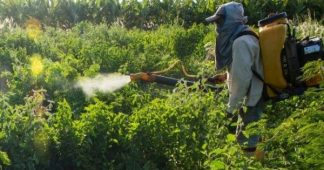By Dilyana Gaytandzhieva
New evidence has emerged of gross violations during the UK investigation into the alleged poisoning of Sergei and Yulia Skripal in Salisbury on 4th March 2018. The new revelations put into question the main evidence that the Skripals were poisoned with the nerve agent Novichok.
The blood samples taken from the Skripals could have been tampered with so that they test positive for Novichok, newly disclosed information obtained from the UK Ministry of Defense reveals. Furthermore, documents show that Russia was not the only country in the world that could be linked to the nerve agent Novichok.
The US had covered up its own Novichok program masked as research on fourth generation nerve agents (FGAs) and muzzled the Organisation for the prohibition of chemical weapons (OPCW) a decade before the Skripals attack.
Breach of chain of custody
Newly disclosed information obtained from the UK Ministry of Defense (MOD) under the Freedom of Information Act questions the integrity of the main evidence that the Skripals were poisoned with Novichok, namely their blood samples. The ministry is in charge of the British military laboratory DSTL Porton Down which analyzed the Skripals blood samples and reportedly identified Novichok.
“Our searches have failed to locate any information that provides the exact time that the samples were collected”, the ministry states. The information held by MOD therefore indicates that the samples were collected at some point between 16:15 on 4 March 2018 and 18:45 on 5 March 2018 (the approximate time according to MOD when the samples arrived at DSTL Porton Down). Even the time of arrival at Porton Down is indicated as “approximate”.
The lack of this information is gross violation and breach of the chain of custody. The UK NHS protocol requires that a request form accompany all specimens sent to the laboratory and clearly state the exact (not approximate) date and time of collection. This newly disclosed information questions the whole Skripals Novichok poisoning story. The fact that the chain of custody of these blood samples was broken directly suggests that they could have been manipulated and tampered with.




According to the UK Defense Ministry document, there is no information as to when exactly (date and time) the blood samples were collected. Hence, these samples are inadmissible evidence in court as without a proper chain of custody the samples could have been manipulated and contaminated with Novichok.
A British toxicologist with extensive knowledge in the field of organophosphate pesticide analysis who wishes to remain anonymous for security reasons has reviewed the MOD document: “It is inconceivable that with such a visibility case, and the obvious significance of any and all biological samples, normal and expected sample logging and documentation did not take place. The person drawing the sample, in any clinical or forensic setting knows that the date and time must be recorded, and the donor positively identified. In a criminal case, evidence gleaned from these samples would be thrown out as inadmissible. Custody seals can be broken and re-applied. In a normal blood draw, the donor would sign the seal which is placed over the vials. In this case, with the donors apparently unconscious, then the phlebotomist would do the signing, and be able to later verify his/her signature on the seal. As we don’t know when, or possibly where the samples were taken, it would be difficult to prove that the seals were in fact the original seals. This lack of protocol is either very sloppy or clandestine.”
What is Chain of Custody and why is it important
The chain of custody is the most critical process of evidence documentation. Chain of Custody (CoC), in legal contexts, refers to the system of controls governing the collection, processing and storage of samples. These controls reduce the potential for samples to be accidentally or maliciously tampered with.

A template of Chain of Custody (CoC) form includes detailed information about each person handling the sample(s) from the time of collection to its receipt by the analyst. This essential information is missing in the Skripals case. Even the time of arrival at Porton Down is “approximate” not exact, according to the UK MoD document.
The chain of custody can be broken if:
- a custody form is labeled incorrectly or is missing information such as exact date and time of collection, transfer and receipt
- if a transfer of evidence takes an unreasonable amount of time, or
- if there is reason to believe the evidence was tampered with
Although even one of the above conditions is enough for the chain of custody to be broken, in the Skripals case all three are present:
- According to MoD, there is no information as to when the samples were collected and the time when they arrived at Porton Down is approximate (not exact)
2. The blood samples arrived at Porton Down 25 hours after the Skripals were admitted to hospital, according to MoD. For reference, the distance between the Salisbury district hospital and Porton Down is only 13 km or an 18-minute drive which means that the transfer of evidence took an unreasonable amount of time.


3.There are four reasons to believe the samples were tampered with since:
3.1. None of the people who were in direct contact with the Skripas tested positive for Novichok. According to the UK government, the nerve agent had been sprayed on the door handle of the Skripals house. Yulia and her father Sergei touched the door handle and few hours later the two collapsed simultaneously on a bench in Salisbury. Meanwhile, few minutes after they had reportedly been poisoned by touching the door handle, the Skripals handed bread to three children to feed ducks. One of the children even ate the bread. This was documented by CCTV footage which the police showed to their parents. Despite the direct contact, no one of the children developed any symptoms of poisoning and their blood tests showed no traces of Novichok.
3.2. We have been told that Novichok is the deadliest nerve agent ever developed. However, none of the alleged “Kremlin targets” (the Skripals and Alexei Navalny) died and all made full recovery without any damage to their health or permanent harm. How is it possible that the deadliest nerve agent in the world has caused no harm to any of the targeted victims and they all fully recovered?
3.3. Sergei Skripal and his daughter Yulia were poisoned with the drug Fentanyl, not the Novichok nerve agent, the initial report on the incident reveals. After I published this report on my Twitter account the information was immediately redacted and the drug Fentanyl was deleted from the original version.
3.4 Porton Down, which received and analyzed the blood samples, had already had Novichok prior to the alleged Skripals poisoning, according to British prime minister Boris Johnson. Although the UK Government publicly lied that only Russia could have been the source of the Novichok nerve agent, as it turns out, Porton Down could have also been the source of the Novichok agent identified coincidentally exactly by Porton Down in the Skripals blood samples.
The Navalny case
The chain of custody can be broken if a transfer of evidence takes an unreasonable amount of time. Such is the case with another alleged nerve agent victim – Alexey Navalny. His biological samples were collected in a German hospital and were delayed by 5 days before being transferred to OPCW designated laboratories, an OPCW document reveals.
Alexey Navalny fell sick during a flight from Tomsk to Moscow on 20th August 2020 and was taken to a hospital in Omsk following an emergency landing. The Russian hospital identified no poison in his blood and attributed his condition to metabolic disorder. At the request of Navalny’s wife Yulia, Russia allowed the patient to be transported for medical treatment in Germany two days later. Germany announced that Russia had poisoned Navalny with Novichock and requested assistance from OPCW. The following timeline of events as described by OPCW clearly shows that the biomedical samples taken from Navalny were inexplicably delayed by 5 days (working days according to the calendar) before being transferred to OPCW designated laboratories:

According to the OPCW report, biomedical samples were taken from Navalny on 6th September. On 11th of September OPCW received a request from Germany (5 working days after the samples were collected) and sent them to OPCW designated labs for analyses. According to recently declassified correspondence between Germany and OPCW about the Navalny alleged poisoning, “the samples’ transmission to OPCW reference laboratories should only take place after the consent by Germany”. Although the samples had already been collected, Germany delayed its permission by 5 days (working days according to the calendar.) There is no explanation as to why Germany delayed its permission for so many days.

Like the UK, Germany also possessed Novichok prior to the Navalny alleged poisoning. The sample was obtained in the 1990s, according to German media. In a joint report, German newspaper Sueddeutsche Zeitung, the weekly Die Zeit and broadcasters NDR and WDR said Germany’s BND spy agency had secured the sample of the Novichok nerve agent from a Russian scientist. The German media report said the BND had informed the U.S. and British intelligence agencies about the case following the analysis, and small amounts of the poison were later produced in several NATO member states. One of these NATO member states was the US.
Documents reveal how US covered up its own Novichok program as research on FGAs
The US Army produced Novichok A-234 (the same nerve agent identified in the Skripals blood samples) in 1998 and in 2002 launched a special Novichok research program masked as research on Fourth generation agents (FGAs), documents reveal.
Dennis Rohrbaugh from the US Army Chemical and Biological Defense Command’s Edgewood Research Development and Engineering Center added the mass spectrometry profile of the Novichok nerve agent A-234 to the 1998-2001 version (NIST 98) of the National Institute of Standards and Technology Mass Spectral Library. The Biochemical facility at Edgewood was making, synthesizing and analysing A-234 for some 20 years before the Skripal attack in Salisbury.

The NIST edition released after the 1998 version had the spectrum removed. According to information obtained from NIST, the entry was withdrawn at the request of a US government department. The spectrum file still exists in the archive but not in any library since 1998.
In 2001 DoD reported to the US Congress that Russian scientists had been publicizing information on a new generation of agents, sometimes referred to as “Novichoks.” A special group composed of senior intelligence officials and scientists, the Chemical and Biological Agents Action Group (CBAAG), was established to address the Fourth Generation Agents (FGAs) threat. At that point only three generations of nerve agents were known. Novichoks are the new fourth generation of nerve agents (FGAs), according to a 2019 DoD report on Forth Generation agents also known as A-series or Novichok nerve agents.

The report states that “No illicit use or manufacture of an FGA or other nerve agent is known to have occurred in the United States”. Source: Fourth Generation Agents: Reference Guide, January 2019
Pentagon papers show exactly the opposite. The US did manufacture FGAs, according to the 2002 DoD Annual report to Congress.
In 2002 the Pentagon launched two programs: TC2 and TC3 involving research on Fourth Generation Agents (FGAs). Among the 2002 targets the document lists:
- Initiate a program of synthesis, toxicology, screening, and characterization of new threat materials (to include Fourth Generation Agents (FGAs) identified as urgent needs while continuing assessment of long term needs;
- Confirm cardiac pathology seen after exposure to FGAs;
- Perform advanced assessment of medical countermeasures in guinea pigs by evaluation of physiological and histopathological parameters. Evaluate bioscavenger pretreatment as medical countermeasure against FGAs in guinea pigs. Conduct advanced assessment (pharmacokinetic and bioavailability) studies of lead medical countermeasures to FGAs in higher animal species for human efficacy estimation.
- Develop surrogate markers in guinea pigs for alternative medical countermeasures for FGA exposure. Develop downselection criteria for choice of the best of the candidates for improved medical countermeasures to FGA exposure.




 Source: DoD Chemical and Biological Defense Program – FY 2001-2003 Performance Plan 2002, Volume II, April 2002US muzzled OPCW Advisory Board Chairman on next generation agents: diplomatic cableIn February 2006, the then chairman of the OPCW scientific advisory board, the Czech Jiri Matousek stated that Novichoks were being developed in Edgewood Research Development and Engineering Center. A diplomatic cable dated 28th February 2006 reveals that the US delegation lied to OPCW that Edgewood was not developing Novichok. Furthermore, a US diplomat forced the Czech Republic to instruct Jiri Matousek not to publicly discuss next generation agents in the future, according to a secret diplomatic cable, entitled: Czechs muzzle Advisory Board chairman on Next Generation Agents (28th March 2006).
Source: DoD Chemical and Biological Defense Program – FY 2001-2003 Performance Plan 2002, Volume II, April 2002US muzzled OPCW Advisory Board Chairman on next generation agents: diplomatic cableIn February 2006, the then chairman of the OPCW scientific advisory board, the Czech Jiri Matousek stated that Novichoks were being developed in Edgewood Research Development and Engineering Center. A diplomatic cable dated 28th February 2006 reveals that the US delegation lied to OPCW that Edgewood was not developing Novichok. Furthermore, a US diplomat forced the Czech Republic to instruct Jiri Matousek not to publicly discuss next generation agents in the future, according to a secret diplomatic cable, entitled: Czechs muzzle Advisory Board chairman on Next Generation Agents (28th March 2006).

Source: WikiLeaks Clinton to US diplomats: Avoid discussion on Fourth Generation Agents
A secret cable dated 26 March 2009 from a US delegate to OPCW reported that at a meeting of the OPCW Data Validation Group in The Hague, “representatives of several countries (Finland, Netherlands, UK) had begun discussing the Mirzayanov book on the margins of the meeting”. Few months earlier a former Soviet scientist, who defected to the US, Vil Mirzayanov published a book revealing publicly the chemical formula of a number of Novichok nerve agents. The US delegate requested further guidance. The cable was addressed to the CIA, the National Security Council, the Secretary of Defense and the Secretary of State.
In a subsequent cable dated 3 April 2009 then Secretary of State Hillary Clinton instructed the US delegation to the Australia Group (informal association of 42 nations that works to prevent the export of chemical and biological weapons) to:
– Avoid any substantive discussion of the Mirazayanov book “State Secrets: An Insider’s View of the Russian Chemical Weapons Program” or so-called ‘Fourth Generation Agents.’
– If AG participants raise the issue of Vils Mirazayonov’s book “State Secrets: An Insider’s View of the Russian Chemical Weapons Program,” the Del should:
– Report any instances in which the book is raised
– Not start or provoke conversations about the book or engage substantively if it comes up in conversation
– Express a lack of familiarity with the issue
– Quietly discourage substantive discussions by suggesting that the issue is best left to experts in capitals
These diplomatic cables show that the US research on Fourth Generation Agents (Novichok) spanned for at least a decade and was kept secret for unknown reasons. In 2012 the Pentagon outsourced much of its nerve agent research to the UK military lab Dstl Porton Down involving tests with nerve agents on animals. Given that Porton Down had Novichok samples at its disposal prior to the Skripals attack, it is highly likely that Novichok was one of the tested nerve agents.
I am an independent journalist and do not work for governments or corporations. If you want to support my work, please go to the Donation page or Become Volunteer. Thank you! If you want to follow me on Telegram, please subscribe to Arms Watch Telegram channel using the link: https://t.me/armswatch
Published at dilyana.bg











